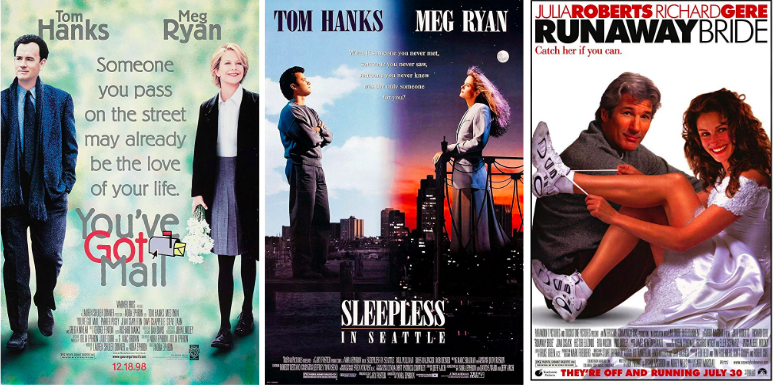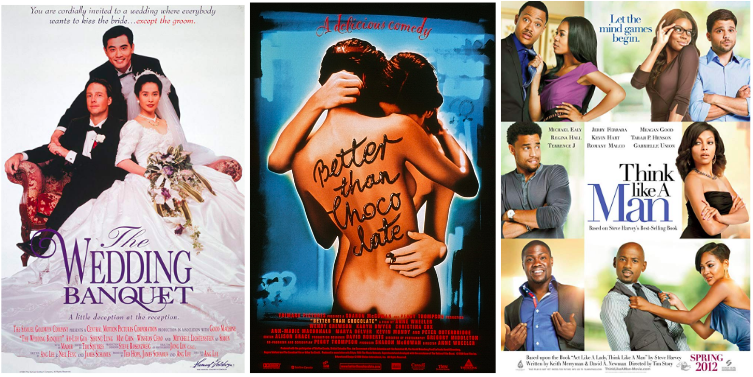From Crazy Rich Asians to Netflix: The “Rebirth” of Romantic Comedies
Katherine E. Morrissey / San Francisco State University

Author’s Note: This column is the first in a three part series about the supposed death and rebirth of the romantic comedy film. In this series, I will be tracing the romantic comedy’s shift from medium-budget Hollywood staple into a smaller-budget Netflix and digital streaming genre.
The romantic comedy is back! At least, that’s what many critics have declared, following the box-office success of Crazy Rich Asians (Chu, 2018) and the media buzz around Netflix’s To All the Boys I’ve Loved Before (Johnson, 2018). Apparently, the rom-com had been dead and is now reborn. The reality, however, is more complicated. The supposed death of the rom-com was less a death and more a morphing and rebranding. Since the 1990s, romantic and comedic story elements have been mobilized across a number of different films and categories that critics, industry, and audiences are reluctant to label romantic comedies.
Why this reluctance to notice the changing shape of romantic comedy? For industry, the issue remains, in part, a marketing issue. Calling something a rom-com comes with risks and threatens the product’s ability to attract mixed-gender audiences. For media scholars, the issue is twofold. First, we are still dealing with resistance to investigating (or enjoying) feminized and supposedly middlebrow popular media. Second, and perhaps more important, many scholars are trained to police the boundaries of genre taxonomies. As such, many look for the most normative examples of a genre and overlook the outliers. For the past 15 years, romantic comedy has been appearing in all sorts of places. However, these romantic comedies do not always fit the “neo-traditional” romantic comedy mold that dominated in Hollywood over the course of the 1980s and 1990s.
Recent shifts in the content and distribution patterns for romantic comedy can only be fully understood when we also consider two important factors: One, the rom-com’s historic role in shoring up white middleclass heterosexuals as the default for romance. Two, the technological, industrial, and economic changes that began unfolding in Hollywood over the course of the late-90s and continue to affect Hollywood production and distribution patterns today.
Where did it go? Distribution Patterns and Neo-Traditional Rom-Coms
Over the course of the 80s and 90s, romantic comedies were widely viewed as a reliable bet at the box office. This was due, in part, to their lower production costs. Romantic comedies didn’t earn as much as the major Hollywood blockbusters. However, as “medium budget” films, they also cost significantly less to produce and had solid domestic and international returns. Runaway Bride (Marshall, 1999), with Julia Roberts and Richard Gere, cost $70 million and earned $309 million worldwide (“Runaway Bride (1999)”). Runaway Bride, Sleepless in Seattle (Ephron, 1993) and You’ve Got Mail (Ephron, 1998) are examples of what Tamar Jeffers McDonald calls the “neo-traditional” romantic comedy (2007). These films overwhelmingly feature white, straight, cis-gender, and middle-class protagonists. They also emphasize “imprecise nostalgia,” tend to intertextually reference past romantic comedies and dramas, and deemphasize sex (McDonald 136).

These market-safe neo-traditional stories served as industry counterprogramming in the 1980s and 90s. These were “films that would appeal to that segment of the audience not usually attracted to the male-oriented ‘tentpole’ films” (Radner 117). Rom-coms in the late 20th century were a useful pallet cleanser, counterprogramming to entice audiences not explicitly hailed by the bigger blockbusters.
However, between 2000 and 2009, there were significant economic shifts in Hollywood and the ownership of major studios.[1] More emphasis was placed on large-scale media franchises spread out across the various production/entertainment arms of media conglomerates. This left much less room in studio budgets for stand-alone medium-budget “chick flicks.” The films that survived were crafted to appeal to more mixed-gender audiences. For example, a cycle of more bro-friendly, raunchy, kinda romantic-comedy films followed the success of the Farrelly Brother’s There’s Something About Mary (1998). Examples of this cycle include The 40-Year- Old Virgin (Apatow, 2005) and Knocked Up (Apatow, 2007). These films reflect an effort at rebranding and eschewing the “chick-flick” label more than they do a radical departure in rom-com content.
The “Other” Rom-Coms
A quieter and more significant morphing in the rom-com genre began in the 1980s and 90s. During this period, the romantic comedy was being “remodeled for (and appropriated by) niche audiences defined by ethnicity, sexual orientation or age” (Krutnik 130). Frank Krutnik tracks a series of innovations in the genre, including an increasing number of romantic comedy films focused on African-American characters and same-sex relationships (2002). Many of the films Krutnik identifies were not marketed as romantic comedies. Instead, they tended to be positioned as African-American, Black or urban comedies. Or, they might be labeled queer, art, or independent cinema. (For example, Booty Call [Pollack, 1997] or The Best Man [Lee, 1999] and The Wedding Banquet [Lee, 1993] or Better Than Chocolate [Wheeler, 1999].) Were these films romantic comedies? I say yes. Would everyone in the audience or industry want to call these films rom-coms? I doubt it.

In 2013, Tatiana Siegel at The Hollywood Reporter declared that the rom-com was, essentially, dead. And, in terms of the neo-traditional rom-coms that audiences became accustomed to in the late 20th century, that certainly seems to have been true. However, just because one dominant type of romantic comedy faded from view, that doesn’t mean romantic comedy film actually died. In 2014, Vanity Fair reporter Kate Erbland issued a correction. The rom-com was not dead, it just was “no longer the playground of big studios.” Erbland points out two things: 1) the genre was alive and well in the indie film market and 2) when major studios did make rom-coms they were typically “aimed at black audiences.” Think Like a Man (Story, 2012) and About Last Night (Pink, 2014) are two examples of successful romantic comedies featuring predominantly black casts from the 2010s.
These titles are just a few examples of a less recognized but important strain of romantic comedy films that has been steadily remodeling the romantic comedy format since the 1990s. Romantic comedy films were made in the 2000s and 2010s, but they weren’t always fitting into the neo-traditional rom-com mold. Industry, critics, scholars, and audiences seem to struggle with explicitly labelling these films romantic comedy. I suspect this reluctance to label has a lot to do with what we expect the people in a romantic comedy to look like and the audiences we assume a rom-com will cater to.
In my next column, I’ll talk about two films that have been hailed as marking the “rebirth” of romantic comedy, Crazy Rich Asians and To All the Boys I’ve Loved Before. I’ll focus on why these two films were hailed as the return of the rom-com and use these films to trace an ongoing transition in the rom-com’s form and in its distribution patterns.
Image Credits:
- Crazy Rich Asians (Chu, 2018)
- You’ve Got Mail (Ephron, 1998), Sleepless in Seattle (Ephron, 1993), Runaway Bride (Marshall, 1999)
- The Wedding Banquet (Lee, 1993), Better Than Chocolate (Wheeler, 1999), Think Like a Man (Story, 2012)
Balio, Tino. Hollywood in the New Millennium. 2013 edition, British Film Institute, 2013.
Krutnik, Frank. “Conforming Passions?: Contemporary Romantic Comedy.” Genre and Contemporary Hollywood, edited by Steve Neale, British Film Institute, 2002, pp. 130–47.
McDonald, Tamar Jeffers. Romantic Comedy: Boy Meets Girl Meets Genre. Wallflower, 2007.
Radner, Hilary. Neo-Feminist Cinema: Girly Films, Chick Flicks, and Consumer Culture. Routledge, 2011.
“Runaway Bride (1999).” Box Office Mojo, https://www.boxofficemojo.com/movies/?id=runawaybride.htm. Accessed 19 Oct. 2019.
Schatz, Thomas. “New Hollywood, New Millenium.” Film Theory and Contemporary Hollywood Movies, Routledge, 2009, pp. 19–46.
- For more see “New Hollywood, New Millennium” by Thomas Schatz (2009) and Hollywood in the New Millennium by Tino Balio (2013). [↩]
This is great. Looking forward to the next installment of the column.
A few years ago I worked on a project about “Drinking Buddies” as an independent film and a romcom. It stars well-known actors but retains some elements of director Joe Swanberg’s earlier mumblecore films. Most of the paratexts positioned it as a romcom, and it got pretty wide ancillary distribution via Redbox and iTunes. Many interesting viewer responses on social media… maybe I’ll pick it back up again.
Thanks for the eye-opening post!
I love this, Katie. Maybe you’ll talk about this in the next column, but it occurs to me that a giant market for rom-coms not mentioned in this one is the cable market. How can Crazy Rich Asians mean the rebirth of something that’s been flourishing on television for years? (Well, I know how “they” would explain it, but…) Looking forward to the next installment!
I don’t think that was a political movie; instead, I feel it was a feel good movie that has all family emotions that includes, love, emotion, drama, action, comedy, romance and all. Now you can also watch similar movies and tv shows on your android phone with the help of the ThopTv application.
Pingback: 'The Broken Hearts Gallery' Won't Break Your Heart | The Emory Wheel
These titles are just a few examples of a less recognized but important strain of romantic comedy films that has been steadily remodeling the romantic comedy format since the 1990s. Romantic comedy films were made in the 2000s and 2010s, but they weren’t always fitting into the neo-traditional rom-com mold. Industry, critics, scholars, and audiences seem to struggle with explicitly labelling these films romantic comedy. I suspect this reluctance to label has a lot to do with what we expect the people in a romantic comedy to look like and the audiences we assume a rom-com will cater to.